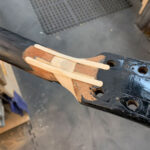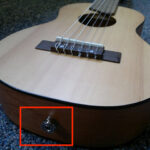Playing power chords on a guitar is an essential skill for any aspiring rock, punk, or metal guitarist, and at guitarplayers.net, we’re here to help you master them, so get ready to unlock a world of simple yet powerful sounds that will form the foundation of countless iconic riffs and songs. This comprehensive guide will take you from the basics of power chords to more advanced techniques, ensuring you have the knowledge and skills to rock out with confidence, and also we will cover guitar chord progressions and guitar playing techniques.
1. What Are Power Chords and Why Learn Them?
Power chords are simplified guitar chords consisting of only two notes: the root and the fifth, they are neither major nor minor, making them incredibly versatile for various musical styles.
1.1 The Essence of Power Chords
Power chords are essentially two-note chords, typically comprising the root note and the fifth interval, and sometimes with the root note doubled an octave higher. According to research from the Berklee College of Music, power chords versatility stems from their lack of a major or minor third, allowing them to fit seamlessly into both major and minor key progressions, providing a foundation for rock, metal, and punk genres.
1.2 Why Power Chords Matter
Learning power chords is crucial for guitarists because they are easy to play, versatile, and fundamental to many genres of music. Guitar World notes that power chords form the backbone of countless rock and metal riffs due to their simplicity and impactful sound.
1.3 The Simplicity Factor
Power chords are easier to play compared to full chords, making them perfect for beginners. Their simplified structure allows for quick transitions and faster playing.
1.4 Versatility Across Genres
Power chords aren’t limited to just rock and metal; they can be found in pop, punk, and even country music. Their neutral tonality allows them to fit into various musical contexts.
1.5 Foundational Knowledge
Mastering power chords provides a solid foundation for learning more complex chord voicings and guitar techniques, Guitar Player Magazine emphasizes that understanding power chord construction helps in grasping music theory concepts.
2. Understanding the Anatomy of a Power Chord
Breaking down the power chord structure reveals its simplicity and versatility, knowing how it’s built helps in transposing and creating new chord progressions.
2.1 The Root Note
The root note is the fundamental pitch of the chord, determining its name and tonal center, it’s the starting point for building the power chord.
2.2 The Fifth Interval
The fifth interval is the note that is seven semitones (or five whole steps) away from the root, creating a strong and consonant sound, this interval defines the power chord’s characteristic sound.
2.3 Optional Octave
Adding an octave of the root note doubles the sound, making it fuller and more powerful, this is commonly used in heavier genres like metal.
2.4 Example: A5 Power Chord
In an A5 power chord, “A” is the root note, and “E” is the fifth interval, played together, they create the A5 power chord.
2.5 Why This Structure Works
The combination of the root and fifth intervals creates a sound that is neither major nor minor, allowing it to fit into various harmonic contexts, this is why power chords are so versatile.
3. Essential Finger Placement for Power Chords
Proper finger placement is key to playing power chords cleanly and efficiently, ensuring that you can switch between them smoothly and maintain a consistent sound.
3.1 The Index Finger
The index finger typically frets the root note on the lower string (E or A string), providing the foundation of the chord, its placement is crucial for muting unwanted strings.
3.2 The Ring Finger
The ring finger usually frets the fifth interval on the string above the root note, completing the basic power chord shape, some guitarists prefer using the pinky finger instead.
3.3 Muting Technique
Muting the strings below the root note and above the fifth interval is essential to avoid muddy sounds, using the fretting hand to mute is a common technique.
3.4 Finger Arch
Maintain a slight arch in your fingers to ensure you’re only pressing down on the intended strings, this prevents accidental muting of the notes you want to ring out.
3.5 Wrist Position
Keep your wrist relaxed and avoid bending it excessively, as this can lead to strain, a comfortable wrist position allows for smoother chord changes.
4. Open Position Power Chords
Open position power chords are played using open strings, making them accessible for beginners and useful for creating specific tonal qualities, they’re easy to learn and sound great.
4.1 E5 Power Chord
The E5 power chord uses the open E string as the root and the 2nd fret of the A string for the fifth, creating a powerful open sound.
4.2 A5 Power Chord
The A5 power chord uses the open A string as the root and the 2nd fret of the D string for the fifth, another fundamental chord in rock and punk.
4.3 D5 Power Chord
The D5 power chord uses the open D string as the root and the 2nd fret of the G string for the fifth, offering a different tonal flavor compared to E5 and A5.
4.4 Finger Placement Tips
Use your index finger to fret the 2nd fret of the A, D, or G string, keeping your finger close to the fret for a clear sound.
4.5 Common Progressions
Open position power chords are often used in progressions like E5-A5-D5, providing a simple yet effective foundation for songs.
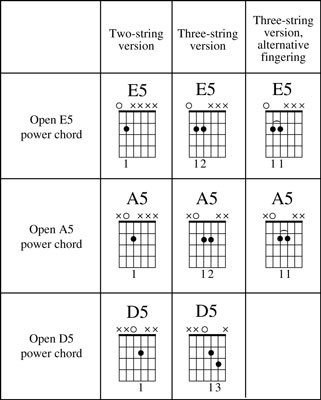 Open position power chords
Open position power chords
5. Movable Power Chords: The Key to Versatility
Movable power chords allow you to play the same chord shape in different positions on the neck, providing access to a wide range of keys and sounds, they are essential for playing riffs and progressions across the fretboard.
5.1 E-Shape Power Chords
E-shape power chords are based on the shape of an open E5 chord, but played higher up the neck, making them movable.
5.2 A-Shape Power Chords
A-shape power chords are based on the shape of an open A5 chord, allowing for different voicings and positions.
5.3 Root on the E String
When the root is on the E string, the power chord shape typically involves fretting the root with the index finger and the fifth with the ring finger (or pinky) two frets higher on the A string.
5.4 Root on the A String
When the root is on the A string, the power chord shape involves fretting the root with the index finger and the fifth with the ring finger (or pinky) two frets higher on the D string.
5.5 Example: F5 Power Chord
To play an F5 power chord, fret the 1st fret of the E string (F) with your index finger and the 3rd fret of the A string (C) with your ring finger.
5.6 Example: Bb5 Power Chord
To play a Bb5 power chord, fret the 6th fret of the E string (Bb) with your index finger and the 8th fret of the A string (F) with your ring finger.
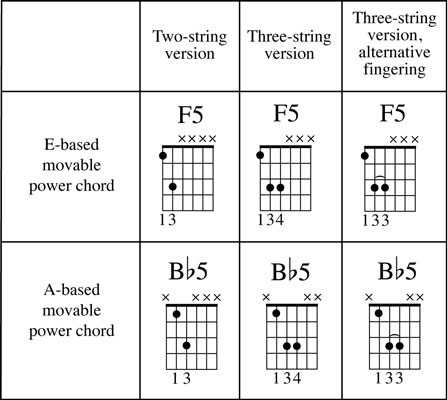 Movable power chords
Movable power chords
6. Power Chord Progressions: Building Blocks of Rock
Power chord progressions form the foundation of countless rock, punk, and metal songs, understanding how to create and use them is crucial for songwriting and improvisation.
6.1 Common Progressions
Popular power chord progressions include I-IV-V (e.g., E5-A5-B5) and i-iv-v in minor keys (e.g., Em5-Am5-Bm5).
6.2 Transposing Progressions
Movable power chords allow you to easily transpose progressions to different keys, maintaining the same relationships between chords.
6.3 Adding Variation
Experiment with adding passing chords, changing the rhythm, or incorporating slides to make your progressions more interesting.
6.4 Example Progression
A simple yet effective progression is E5-G5-A5-B5, providing a classic rock sound.
6.5 Minor Key Progressions
In minor keys, a progression like Am5-G5-F5 can create a darker, more intense feel.
7. Techniques to Enhance Your Power Chord Playing
Various techniques can add depth and interest to your power chord playing, from palm muting to slides and hammer-ons.
7.1 Palm Muting
Palm muting involves resting the edge of your picking hand on the strings near the bridge to create a dampened, percussive sound, it’s commonly used in metal and hard rock.
7.2 Slides
Sliding between power chords adds a smooth transition and can create a sense of movement, slide up or down the neck while maintaining the chord shape.
7.3 Hammer-Ons and Pull-Offs
Using hammer-ons and pull-offs within or between power chords can add rhythmic complexity and interest, these techniques involve striking or pulling off a string with a fretting finger.
7.4 Vibrato
Adding vibrato to sustained power chords can give them more expression and sustain, gently wiggle your fretting finger back and forth to create the vibrato effect.
7.5 Chunking
Chunking involves playing power chords with a percussive, rhythmic attack, often combined with muting for a driving, aggressive sound.
8. The Role of Distortion and Overdrive
Distortion and overdrive are essential effects for power chord-based music, adding sustain, thickness, and aggression to your sound.
8.1 Understanding Distortion
Distortion is an effect that adds harmonics and sustain to your guitar signal, creating a saturated, aggressive tone, it’s a staple of rock and metal.
8.2 Understanding Overdrive
Overdrive is a milder form of distortion, providing a warm, boosted tone without the extreme saturation, it’s often used in blues and classic rock.
8.3 Stacking Effects
Experiment with stacking overdrive and distortion pedals to create different levels of gain and tonal characteristics, combining effects can create unique sounds.
8.4 Amp Settings
Adjust your amplifier’s gain and EQ settings to optimize your power chord tone, finding the right balance is crucial.
8.5 Pedal Recommendations
Popular distortion and overdrive pedals include the Ibanez Tube Screamer, Pro Co RAT, and Boss DS-1, these pedals are widely used in rock and metal.
9. Power Chords in Different Genres
Power chords are versatile and can be used in various genres, each with its unique approach and application.
9.1 Rock
In rock, power chords are often used for rhythm guitar parts, providing a driving, energetic sound, think of bands like The Who and AC/DC.
9.2 Punk
Punk music utilizes power chords for their simplicity and raw energy, often played fast and aggressively, bands like The Ramones and The Sex Pistols are prime examples.
9.3 Metal
Metal music relies heavily on power chords for creating heavy, aggressive riffs, often with dropped tunings and high gain, bands like Metallica and Black Sabbath are known for their power chord-driven sound.
9.4 Pop-Punk
Pop-punk combines the energy of punk with pop sensibilities, using power chords in catchy, upbeat songs, bands like Blink-182 and Green Day are popular examples.
9.5 Alternative Rock
Alternative rock uses power chords in more experimental and melodic ways, often with unconventional chord progressions, bands like Nirvana and Smashing Pumpkins demonstrate this versatility.
10. Famous Songs That Use Power Chords
Learning songs that feature power chords is a great way to improve your skills and understand their application in real-world musical contexts.
10.1 “Smoke on the Water” by Deep Purple
This iconic riff is based on a simple yet powerful power chord progression, demonstrating the effectiveness of basic chord shapes.
10.2 “Iron Man” by Black Sabbath
“Iron Man” features heavy, distorted power chords that define the song’s ominous and powerful sound.
10.3 “Blitzkrieg Bop” by The Ramones
This punk anthem uses fast, simple power chords to create its energetic and infectious feel.
10.4 “Smells Like Teen Spirit” by Nirvana
“Smells Like Teen Spirit” features a dynamic combination of clean and distorted power chords, contributing to the song’s grunge sound.
10.5 “You Really Got Me” by The Kinks
This classic rock song utilizes simple power chords to create a catchy and memorable riff.
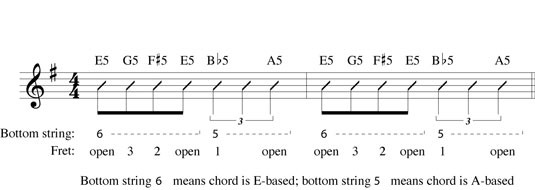 Heavy metal riff using movable and open-position power chords
Heavy metal riff using movable and open-position power chords
11. Common Mistakes to Avoid When Playing Power Chords
Avoiding common mistakes ensures you develop good habits and play power chords cleanly and effectively.
11.1 Not Muting Unwanted Strings
Failing to mute unwanted strings can result in a muddy, unclear sound, use your fretting hand and picking hand to mute effectively.
11.2 Applying Too Much Pressure
Pressing down too hard on the strings can cause tension and fatigue, use just enough pressure to get a clear sound.
11.3 Incorrect Finger Placement
Incorrect finger placement can lead to buzzing or muted notes, ensure your fingers are close to the frets and properly arched.
11.4 Tense Wrist
A tense wrist can cause discomfort and limit your ability to play smoothly, keep your wrist relaxed and flexible.
11.5 Neglecting Intonation
Poor intonation can cause your power chords to sound out of tune, check your guitar’s intonation regularly and adjust as needed.
12. Practicing Power Chords Effectively
Effective practice is key to mastering power chords and incorporating them into your playing.
12.1 Start Slow
Begin by practicing power chords slowly to ensure proper finger placement and technique, gradually increase your speed as you improve.
12.2 Use a Metronome
Practice with a metronome to develop your timing and rhythm, start at a slow tempo and gradually increase it.
12.3 Practice Chord Changes
Focus on smooth and efficient chord changes, practice transitioning between different power chords.
12.4 Play Along with Songs
Play along with songs that use power chords to apply your skills in a musical context, this helps develop your ear and timing.
12.5 Record Yourself
Record yourself playing power chords and listen back to identify areas for improvement, self-assessment is crucial for progress.
13. Advanced Power Chord Techniques
Once you’ve mastered the basics, exploring advanced techniques can add depth and complexity to your power chord playing.
13.1 Drop D Tuning
Drop D tuning involves tuning your low E string down to D, creating a heavier, more resonant sound, it’s commonly used in metal and hard rock.
13.2 Power Chord Inversions
Power chord inversions involve changing the order of the notes in the chord, creating different voicings and tonal colors, experiment with different inversions to add variety.
13.3 Hybrid Picking
Hybrid picking combines a pick with your fingers to create unique textures and rhythms, use hybrid picking to add accents and dynamics to your power chord playing.
13.4 Tapping
Tapping involves using your fretting and picking hand fingers to tap notes on the fretboard, creating fast and intricate melodies, incorporate tapping into your power chord riffs.
13.5 Sweep Picking
Sweep picking involves using a single, continuous motion of the pick across multiple strings, creating fast and fluid arpeggios, adapt sweep picking techniques to power chords for a unique sound.
14. Gear Recommendations for Power Chord Players
Having the right gear can significantly enhance your power chord playing experience, from guitars to amplifiers and effects pedals.
14.1 Guitars
Guitars with humbucker pickups are ideal for power chords, providing a thick, powerful sound, popular choices include Gibson Les Pauls and Fender Telecasters with humbuckers.
14.2 Amplifiers
High-gain amplifiers are essential for achieving a heavy, distorted tone, Marshall, Mesa/Boogie, and Orange are popular amp brands.
14.3 Effects Pedals
Distortion, overdrive, and fuzz pedals are crucial for shaping your power chord tone, experiment with different pedals to find your signature sound.
14.4 Strings
Heavy gauge strings can provide a thicker, more resonant sound for power chords, experiment with different gauges to find what works best for you.
14.5 Picks
Thick picks can provide more attack and control when playing power chords, experiment with different thicknesses and materials.
15. How to Write Your Own Power Chord Riffs
Writing your own power chord riffs is a creative and rewarding process, allowing you to express your musical ideas and develop your unique style.
15.1 Start with a Groove
Begin by finding a rhythm or groove that inspires you, this will form the foundation of your riff.
15.2 Choose a Key
Select a key that suits the mood you’re trying to create, consider using minor keys for darker, more intense riffs.
15.3 Experiment with Chord Progressions
Try different power chord progressions to see what sounds good, don’t be afraid to experiment with unconventional chord choices.
15.4 Add Variation
Incorporate slides, hammer-ons, pull-offs, and other techniques to add interest and dynamics to your riffs.
15.5 Record and Refine
Record your riffs and listen back critically, identify areas for improvement and refine your ideas until you’re satisfied.
16. Integrating Power Chords into Lead Guitar Playing
Power chords can be effectively integrated into lead guitar playing, providing a powerful and dynamic contrast to single-note lines.
16.1 Chord-Based Solos
Use power chords to create chord-based solos, incorporating them into your lead lines.
16.2 Rhythmic Accompaniment
Use power chords to provide rhythmic accompaniment during your solos, adding texture and support.
16.3 Transitioning Between Chords and Leads
Practice transitioning smoothly between power chords and lead lines, creating seamless musical passages.
16.4 Call and Response
Use power chords in a call-and-response format with your lead lines, creating a dynamic and engaging musical conversation.
16.5 Dynamics
Incorporate dynamics into your power chord and lead guitar playing, using variations in volume and intensity to create emotional impact.
17. Power Chords and Songwriting
Power chords are a valuable tool for songwriting, providing a simple yet effective foundation for creating catchy and memorable songs.
17.1 Versatility
Power chords can be used in various genres, making them versatile for songwriting.
17.2 Simplicity
Their simplicity allows you to focus on melody and lyrics.
17.3 Foundation
They provide a solid foundation for building your song’s structure.
17.4 Hooks
Power chords can create catchy hooks and riffs.
17.5 Emotional Impact
Use power chords to convey emotions and create atmosphere.
18. Power Chord Exercises to Improve Technique
Specific exercises can help improve your power chord technique, focusing on accuracy, speed, and control.
18.1 Finger Dexterity
Practice scales and arpeggios to improve finger dexterity.
18.2 Chord Transitions
Practice smooth transitions between power chords.
18.3 Rhythm Training
Use a metronome to improve rhythm and timing.
18.4 Muting Exercises
Focus on muting unwanted strings for a clean sound.
18.5 Endurance
Gradually increase practice time to build endurance.
19. Maintaining Your Guitar for Optimal Power Chord Sound
Proper guitar maintenance is essential for achieving the best possible power chord sound, ensuring your instrument is in top playing condition.
19.1 String Changes
Change your strings regularly to maintain optimal tone and playability, fresh strings sound brighter and more resonant.
19.2 Intonation Adjustments
Ensure your guitar’s intonation is properly set, allowing your power chords to sound in tune across the fretboard.
19.3 Action Adjustments
Adjust your guitar’s action (string height) to suit your playing style, lower action makes it easier to fret chords, while higher action can prevent buzzing.
19.4 Fretboard Cleaning
Clean your fretboard regularly to remove dirt and grime, keeping it smooth and playable.
19.5 Hardware Maintenance
Inspect and maintain your guitar’s hardware, such as tuners and bridge, to ensure they are functioning properly.
20. The Future of Power Chords
Power chords have a rich history and continue to evolve, remaining a vital part of modern music.
20.1 Evolution
Power chords have evolved over time, adapting to different genres and styles.
20.2 Innovation
Guitarists continue to innovate with power chords, exploring new techniques and sounds.
20.3 Digital Music
Power chords are used in digital music production, creating unique soundscapes.
20.4 New Genres
They are adapted into new genres, pushing musical boundaries.
20.5 Enduring Appeal
Power chords have an enduring appeal, remaining a staple in music.
Ready to unleash the power? Visit guitarplayers.net for a wealth of resources, including lessons, reviews, sheet music, and our thriving community forum, where you can connect with fellow guitarists, share your progress, and get personalized feedback. Whether you’re seeking structured lessons, in-depth gear reviews, or a place to showcase your riffs, guitarplayers.net is your ultimate destination. Join us today at 1140 Boylston Street, Boston, MA 02215, United States, or call us at +1 (617) 747-2261, and let’s make some noise together!
FAQ: Power Chords on Guitar
1. What exactly is a power chord on the guitar?
A power chord is a simplified guitar chord consisting of the root note and the fifth interval, creating a powerful and versatile sound suitable for various genres.
2. Why are power chords so important for guitarists to learn?
Power chords are easy to play, versatile, and form the foundation of many rock, punk, and metal songs, making them essential for any aspiring guitarist.
3. How do I properly place my fingers to play a power chord?
Typically, the index finger frets the root note on the lower string, and the ring finger (or pinky) frets the fifth interval on the string above, ensuring proper muting of unwanted strings.
4. Can you provide examples of open position power chords?
Common open position power chords include E5 (open E string and 2nd fret of the A string), A5 (open A string and 2nd fret of the D string), and D5 (open D string and 2nd fret of the G string).
5. What are movable power chords and how do they work?
Movable power chords are based on the shapes of open E5 and A5 chords, allowing you to play the same chord shape in different positions on the neck to access various keys.
6. What is the role of distortion and overdrive in power chord playing?
Distortion and overdrive add sustain, thickness, and aggression to your power chord sound, enhancing the overall impact and intensity, making them crucial for rock and metal genres.
7. What are some famous songs that heavily feature power chords?
Examples include “Smoke on the Water” by Deep Purple, “Iron Man” by Black Sabbath, “Blitzkrieg Bop” by The Ramones, and “Smells Like Teen Spirit” by Nirvana.
8. How can I avoid common mistakes when playing power chords?
Avoid not muting unwanted strings, applying too much pressure, incorrect finger placement, a tense wrist, and neglecting intonation to ensure clean and effective power chord playing.
9. What are some exercises to improve my power chord technique?
Practice finger dexterity exercises, chord transitions, rhythm training with a metronome, muting exercises, and gradually increase practice time to build endurance.
10. How do I maintain my guitar for the best power chord sound?
Regular maintenance includes changing strings, adjusting intonation and action, cleaning the fretboard, and inspecting hardware to ensure your guitar is in top playing condition for optimal sound.

